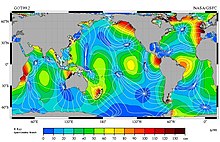Incredible natural phenomena
Nature is mysterious and unpredictable, and often leaves us open-mouthed at the inexplicable manifestations of its power. Though you may think moving rocks and blood-coloured rain is some sort of joke or miraculous occurrence, science has an explication for (almost) everything.
From our point of view, Mother Nature continues to be a fascinating mystery. So let’s take a look at eight of the most amazing natural phenomena.
1. Northern Lights, Iceland

An aurora, sometimes referred to as polar lights, northern lights, or southern lights, is a natural light display in the Earth's sky, predominantly seen in high-latitude regions (around the Arctic and Antarctic).
Auroras are the result of disturbances in the magnetosphere caused by solar wind. These disturbances are sometimes strong enough to alter the trajectories of charged particles in both solar wind and magnetospheric plasma. These particles, mainly electrons and protons, precipitate into the upper atmosphere.
The resulting ionization and excitation of atmospheric constituents emit light of varying color and complexity. The form of the aurora, occurring within bands around both polar regions, is also dependent on the amount of acceleration imparted to the precipitating particles. Precipitating protons generally produce optical emissions as incident hydrogen atoms after gaining electrons from the atmosphere. Proton auroras are usually observed at lower latitudes.
2. Sort sol, Denmark
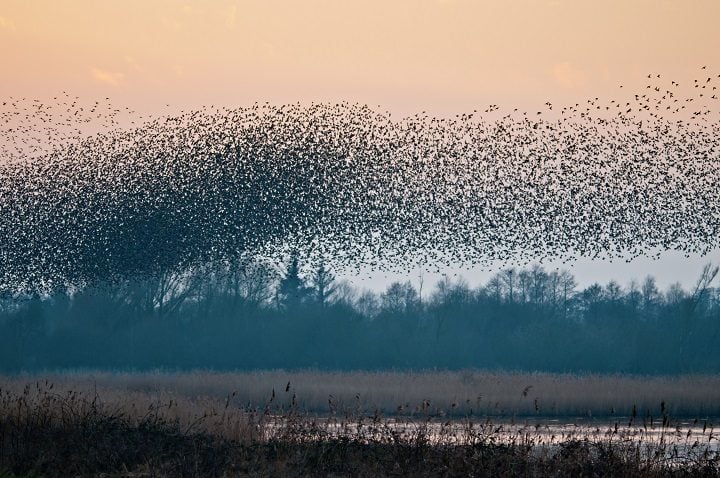
Sort sol is a murmuration, nature phenomenon in the marshlands in southwestern Jutland, Denmark, in particular the marsh near Tønder and Ribe. Very large numbers of migratory starlings gather there in spring and autumn when they move between their winter grounds in southern Europe and their summer breeding grounds in Scandinavia and other countries near the Baltic Sea.
Sort sol takes place in the hours just after sunset. The birds gather in large flocks and form huge formations in the sky just before they decide for a location to roost for the night. The movements of the formations have been likened to kind of a dance or ballet and the birds are so numerous that they seem to obliterate the sunset, hence the term "sort sol". Sort sol in the marsh near Tønder can occasionally comprise a formation with up to one million birds. Usually flocks break up when the number of individuals exceed about half a million birds due to excessive internal disturbances in the flock.
If a predator bird enters the flock, the starlings initiate a veritable bombardment with droppings and vomit that soil the feathers of the predator. In rare cases the sticky deposits may render the predator unable to stay airborne. Over 20 years, there have been two confirmed cases of young northern goshawks who drowned because the incident took place over water.
3. Lightning storm, Venezuela
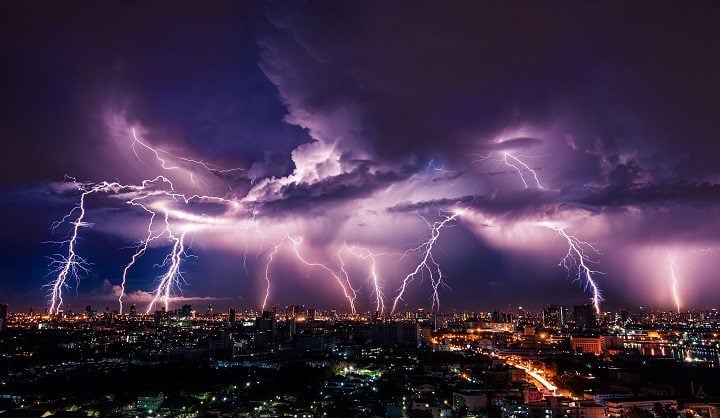
Catatumbo lightning is an atmospheric phenomenon which occurs over the mouth of the Catatumbo River where it empties into Lake Maracaibo in Venezuela. It originates from a mass of storm clouds at a height of more than 1 km, and occurs during 140 to 160 nights a year, 10 hours per day and up to 280 times per hour. It occurs over and around Lake Maracaibo, typically over a bog area formed where the Catatumbo River flows into the lake.
The lightning changes its frequency throughout the year, and it is different from year to year. For example, it ceased from January to March 2010, apparently due to drought, leading to speculation that it might have been extinguished permanently.
4. Moonbow, Zimbabwe

A moonbow is a rainbow produced by moonlight rather than direct sunlight. Other than the difference in the light source, its formation is the same as for a solar rainbow: It is caused by the refraction of light in many water droplets, such as a rain shower or a waterfall, and is always positioned in the opposite part of the sky from the moon relative to the observer.
Moonbows are much fainter than solar rainbows, due to the smaller amount of light reflected from the surface of the moon. Because the light is usually too faint to excite the cone color receptors in human eyes, it is difficult for the human eye to discern colors in a moonbow. As a result, a moonbow often appears to be white. However, the colors in a moonbow do appear in long exposure photographs.
5. Sailing stone/moving rock, USA
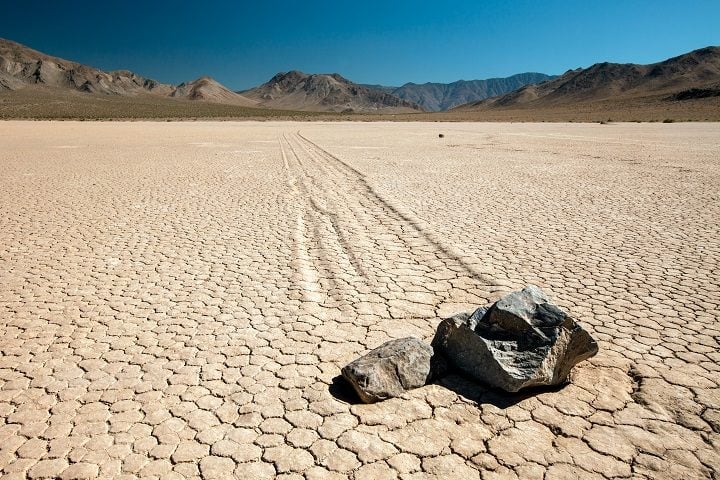
Sailing stones are part of the geological phenomenon in which rocks move and inscribe long tracks along a smooth valley floor without animal intervention. The movement of the rocks occurs when large sheets of ice a few millimeters thick and floating in an ephemeral winter pond break up on sunny days. Frozen during cold winter nights, these thin, floating ice panels are driven by wind and shove rocks at speeds up to 5 meters per minute.
Trails of sliding rocks have been observed and studied in various locations, including Little Bonnie Claire Playa, in Nevada,[1] and most famously at Racetrack Playa, Death Valley National Park, California, where the number and length of tracks are notable.
6. Blood rain, India

7. Pororoca, Brazil
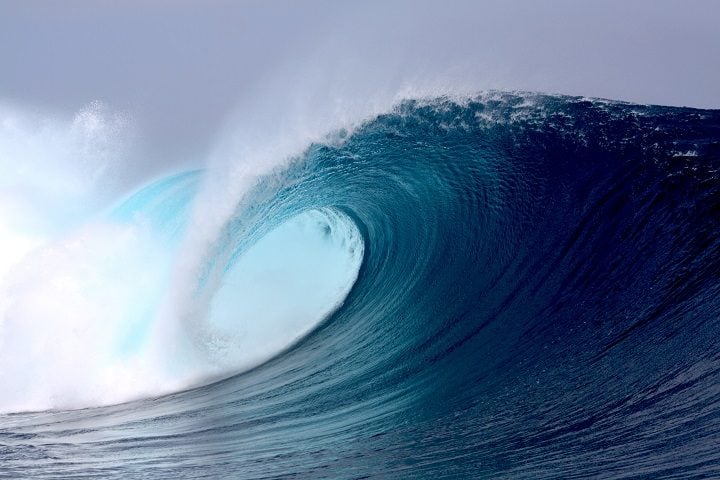
The Pororoca is a tidal bore, with waves up to 4 m (13 ft) high that travel as much as 800 km (500 mi) inland upstream on the Amazon River and adjacent rivers. Its name maybe comes from the indigenous Tupi language, where it could translate into "great roar". It could be also a Portuguese version of the term poroc-poroc, which in an indigenous' language was a way of expressing the act of destroying everything. It could be also a portmanteau of the words poroc (to take out, to tear away) and oca (house). It occurs at the mouth of the river where its waters meet the Atlantic Ocean.
Explanation:
During new and full moons, when the ocean tide is highest, water flows in from the Atlantic, rather than the other way around. The Amazon's flow reverses, the distance of which depends largely on the rainwater-generated outflow of the Amazon, and a water bulge speeds upstream often with great force, forming a tidal bore with an audible noise. The tidal phenomenon is best observed on biannual equinoxes in September and March during a spring tide. On an equinoctial spring tide, the Moon and Sun fall into direct alignment with the Earth, and their gravitational pull is combined, bringing the Pororoca and others around the world to their peak.
Surfing:
The wave has become popular with surfers. Since 1999, an annual championship has been held in São Domingos do Capim . However, surfing the Pororoca is especially dangerous, as the water contains a significant amount of debris from the shores of the river (often entire trees), in addition to dangerous fauna. In 2003 the Brazilian Picuruta Salazar won the event with a record ride of 12.5 km (7.8 mi) lasting 37 minutes.
#nature #Incrediblenaturalphenomena
